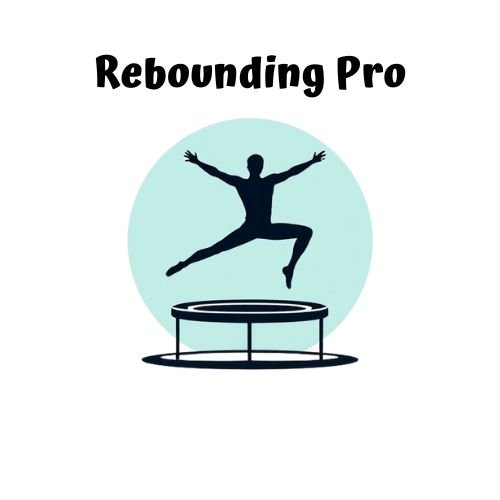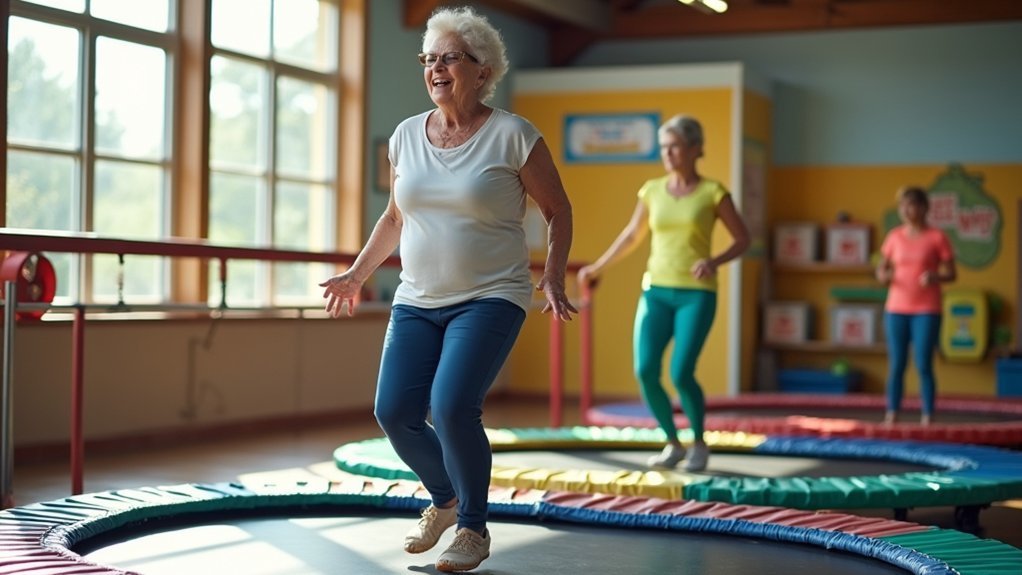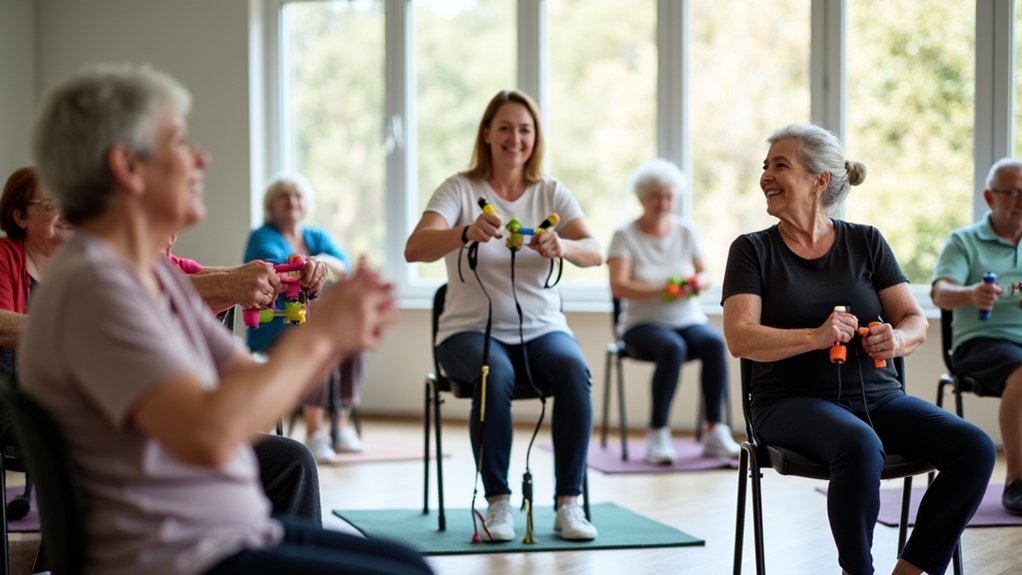The three best safety practices for senior bouncing exercise include using a rebounder with sturdy handlebars for support, maintaining proper form with slightly bent knees to absorb shock, and creating a hazard-free environment with the rebounder on a flat surface away from obstacles. Always consult your doctor before starting, begin with short sessions, and stop if you experience pain or dizziness. These foundational practices guarantee you’ll bounce your way to better health while minimizing risks.
Selecting Age-Appropriate Rebounding Equipment

When choosing a rebounder for senior exercise, safety and comfort should be your top priorities.
Consider rebounders with bungee cord mechanisms rather than springs, as they provide gentler bounces that are easier on aging joints while producing less noise.
Bungee cord rebounders deliver gentler impact, protecting senior joints while offering a quieter workout experience.
Look for models with adjustable, padded safety handlebars to provide support and build confidence during your workouts.
Verify the rebounder can adequately support your weight and features non-slip feet for stability.
If space is limited, opt for a foldable design that’s easy to store. Pre-assembled models save you from complicated setup procedures.
For long-term value, select equipment with replaceable parts.
A high-quality rebounder should maintain stability during exercise, which is particularly important for seniors who may have balance concerns.
Before starting any rebounding routine, consult your doctor to confirm it’s suitable for your specific health conditions.
Proper Form and Movement Modifications for Joint Protection
Proper form during rebounding exercises serves as the foundation for both safety and effectiveness, especially for seniors concerned about joint health.
Always maintain slightly bent knees to absorb shock and keep your weight evenly distributed with emphasis on your heels. Engage your core by drawing your navel toward your spine to support your back and pelvis.
Opt for gentle health bouncing without lifting your feet off the mat rather than high jumps. During health bounces, maintain a micro bend in knees and slight forward hinge at the waist for optimal stability. Side-to-side movements enhance balance while minimizing joint stress.
If you have limited mobility, try seated bouncing exercises and use your arms for added stability. Incorporate light upper body movements during your routine and always finish with gentle stretches.
Remember to breathe steadily and focus on controlled movements rather than height. Start with short sessions and gradually increase as your strength improves.
Creating a Safe Exercise Environment for Stability and Support

Creating a safe exercise environment extends beyond proper form to include your equipment selection and physical surroundings.
Choose a rebounder that supports your weight with either bungee cords for gentler bouncing or springs for more intensity. Look for models with adjustable, padded handlebars for extra stability during your workout.
Position your rebounder on a flat, stable surface with ample clearance from walls and furniture. Regularly inspect the mat and tension mechanisms for wear. It’s crucial to keep trampoline away from obstacles to prevent potential injuries during your rebounding session.
If you’re new to rebounding, consider working with a fitness instructor to learn proper techniques.
Don’t forget to keep water nearby and listen to your body’s signals. If you experience pain or dizziness, stop immediately.
Having another person nearby during your sessions adds an extra layer of safety through mutual supervision.
Frequently Asked Questions
How Long Should Seniors Rebound in a Single Session?
You should rebound for 5-10 minutes initially, gradually increasing by 2-3 minutes weekly. Keep single sessions under 15 minutes as a beginner, and limit your total daily rebounding to 20-30 minutes for safety.
Can Rebounding Help With Age-Related Balance Issues?
Yes, rebounding can greatly help with your age-related balance issues. You’ll activate your proprioceptive system, strengthen core muscles, and improve coordination through consistent practice, reducing your fall risk over time.
Should Seniors Wear Compression Garments During Rebounding Exercises?
Compression garments might help you during rebounding by improving circulation and reducing muscle vibration. Consider lightweight options with moderate compression (15-20 mmHg), but check with your doctor first if you have circulation issues.
How Do Medications Affect Safe Rebounding Intensity Levels?
Medications can greatly impact your rebounding safety. You’ll need to adjust intensity if you’re taking balance-affecting drugs like benzodiazepines or blood pressure medications. Always monitor symptoms and consult your doctor before starting new exercises.
Can Rebounding Exercises Improve Bone Density in Seniors?
Rebounding offers limited bone density benefits for seniors. You’ll see minimal gains in femoral neck density (about 2%), but it’s excellent for maintaining existing bone mass and improving balance, which helps prevent falls.
In Summary
By following these three safety practices, you’ll make rebounding a secure and effective exercise option in your golden years. Select equipment designed specifically for seniors, modify movements to protect your joints, and create a stable environment with proper support. Don’t hesitate to start slowly and progress gradually. With these precautions in place, you’ll enjoy the benefits of bouncing while keeping safety your top priority.





Leave a Reply